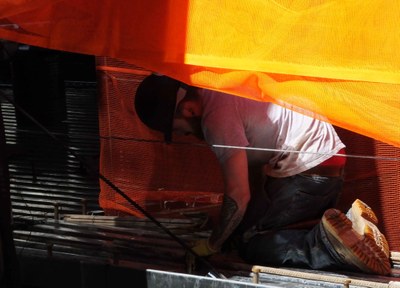Why are suicide rates higher for farmers and firefighters than for librarians?
The largest survey of suicide rates by occupational group shows suicide is ten times more common among farmers than among librarians. For women, the highest rates are found among emergency workers, like firefighters.
There are complex reasons for why people commit suicide. Genetic, individual and social factors are all at play. There are also clear differences between different occupations, ages and between the genders. Greenland tops the statistics in the Nordic region, where 14 times as many men take their own lives compared to men in the Faroe Islands.

Agriculture, fisheries and forestry are all sectors with high suicide rates. One explanation for the high rate among farmers is that they often work alone, while potential financial losses are great in case of failing crops.
But even medical doctors and dentists run a higher risk compared to other occupations. Here the access to knowledge about how to take your own life and access to drugs could play a role.
Teachers and librarians represent the occupations with the lowest suicide rates. A fresh American study covering 17 US states looked at 22 different occupations. The study was carried out by researchers at the National Center for Injury Prevention and Control, CDC. Previous studies have mainly looked at single occupations and states. The numbers are from 2012, when 40 000 Americans committed suicide. It is the tenth most common cause of death in the USA. The researchers classified over 12 000 suicides committed by people above 16 according to different occupations.
The suicide rate among American farmers, fishermen and forestry workers was 84.5 per 100 000 people working in those occupations in the 17 states. The rate among teachers and librarians was less than one tenth of that. These two occupations had a rate of 7.5 suicides per 100 000. The US national average is 12.6 per 100 000 if you include under-16s.
No comparable Swedish study
“It is very positive that so few librarians commit suicide, of course. I have never heard of a comparable Swedish study, but it would be good if the same is true in Sweden,” says Stina Hamberg from DIK, the professional association and trade union for university graduates in the fields of culture and communication.
“One explanation could be that librarians have a higher education, which is usually linked to better health,” she says.
In all of the 22 occupations covered by the study, there are more suicides among men than among women. 77 percent of suicides were committed by men, and 23 percent by women. That is similar to European figures, where there are approximately four male suicides for every female one. China is one of the few countries where more women than men commit suicide.
Among women in the USA, the occupations with the highest suicide rates were police and firefighters, with a rate of 14.1 per 100 000.
Cause and effect
Cause and effect is unclear here. Would a person who is genetically predisposed to commit suicide refrain from doing it if they were in a different occupation? Or are certain high risk groups drawn to certain occupations?
The working environment for some occupations can also influence suicide rates. The American researchers considered whether farmers are being affected by pesticides which influence the nervous system and potentially lead to depression. In the construction industry there are solvents and other chemicals with similar effects.
“No study of the same magnitude has been done in Sweden, so it is difficult to comment on any specific figures in the report. You should be careful drawing firm conclusions on the connection between suicide and different occupations,” says Gergö Hadlaczky, senior researcher at the National Centre for Suicide Research and Prevention of Mental Ill-Health (NASP).
NASP was established in 2007 as Sweden’s national expert institution on suicide prevention. It is part of Karolinska Institutet.
Income more important than occupation?
“The reason why you should be careful is that there are many other variables at play. There are studies that show that income, education and other socio-economic factors to a great degree can explain why occupations sometimes influence the suicide risk. It has also been shown that unemployment can be at least as strong a suicide risk factor as any individual occupation,” says Gergö Hadlaczky.
He points to other studies, like a meta-analysis of 34 scientific papers on suicide published by The British Journal of Psychology. The authors write that one problem with this kind of research is that the limited nature of the source material makes it difficult to identify statistical differences.
According to the researchers in the British study, farmers’ high suicide risk can be explained at least in part by their ease of access to weapons. One New Zealand study showed guns were more often involved in farmers’ suicides, while health sector workers often used a drugs overdose. But the access to weapons cannot fully explain the difference, since guns were not more common among army personnel committing suicide.
One of the largest mental health surveys carried out by the American Army, STARRS (Study to Assess Risk and Resilience in Service members), looked at 1.6 million soldiers who were in active service between 2004 and 2009. The suicide rate was higher than the national average before the soldiers entered into combat and after. During their active service in a conflict zone the number of suicides fell, however, which might be due to the camaraderie formed among the soldiers. The total suicide risk among the soldiers in the US was 18.7 per 100 000. The numbers are from 2013.
Compared with soldiers, librarians have a peaceful workplace. But it is not all a bed of roses. A working environment survey carried out by the DIK association in early 2016 showed librarians often take care of people with social problems or gangs of youths who have no place to go when their youth club closes down. Karin Linder, chair of DIK, summed up the survey like this:

“The working environment in many libraries is unsustainable. One in five have been threatened in their role as a librarian, four in ten have either experienced violence or have witnessed violent episodes in their place of work.
“84 percent say they have experienced aggressive behaviour from visitors, and two in three have experienced vandalism. One in four experiences altercations at least once a week. Half say they have experienced abusive language at work and many are being attacked because of their gender and have their skills questioned.”
- Six occupations with a high suicide rate
-
Occupation Rate /100 000 Farmers, fishermen and forestry workers
84.5 Construction workers and miners
53.3 Fitters
47.9 Industry workers
34.5 Engineers
32.2 Firefighters, police and paramedics
30.5

 Follow us on Facebook
Follow us on Facebook
